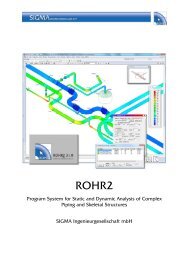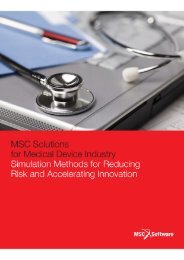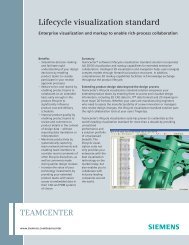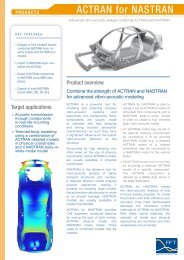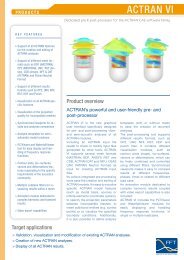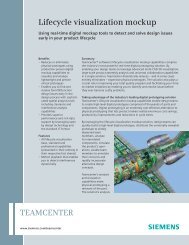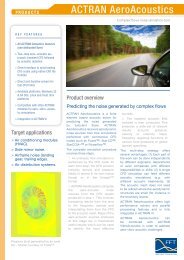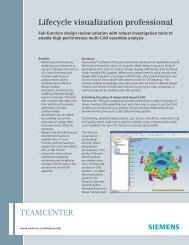FloVENT for data center
FloVENT for data center
FloVENT for data center
You also want an ePaper? Increase the reach of your titles
YUMPU automatically turns print PDFs into web optimized ePapers that Google loves.
Optimizing Data Center Cooling Through Simulation<br />
Why Per<strong>for</strong>m Airflow/Thermal Simulation<br />
in Data Centers?<br />
Providing adequate cooling is a major challenge <strong>for</strong> modern<br />
<strong>data</strong> <strong>center</strong> designers and operators, due to the escalating<br />
power densities associated with blade servers and other high-<br />
speed computing and switching equipment. Individual server<br />
rack heat loads now commonly exceed 10kW, and may reach<br />
over 30kW. According to a recent study [1] , power consumption<br />
in US <strong>data</strong> <strong>center</strong>s doubled between 2000 and 2005, reaching<br />
in 2005 a figure approximately equal to the power consumed<br />
by all color televisions in the USA. Power consumption in <strong>data</strong><br />
<strong>center</strong>s is expected to grow by a further 40% by 2010. Energy<br />
costs <strong>for</strong> power and cooling in <strong>data</strong> <strong>center</strong>s are now greater<br />
than the cost of the IT equipment itself, when amortized over a<br />
three-year period [2] .<br />
The <strong>FloVENT</strong> simulation software from Mentor Graphics<br />
creates a “virtual” <strong>data</strong> <strong>center</strong> with detailed 3D visualization of<br />
airflow and temperature at every point throughout the room.<br />
Armed with this vital in<strong>for</strong>mation, you can quickly and easily:<br />
•<br />
•<br />
•<br />
•<br />
•<br />
Minimize cooling power requirements and energy costs<br />
Optimize <strong>data</strong> <strong>center</strong> cooling effectiveness<br />
Ensure that temperatures are within specifications at all<br />
rack inlets and throughout the room<br />
Eliminate hot spots thus avoiding potential equipment<br />
failures and downtime<br />
Simulate transient effects (e.g. temperature build-up<br />
following CRAC failure)<br />
[1] “Estimating total power consumption by servers in the US<br />
and the world”, Jonathan G. Koomey, Ph.D, Staff Scientist,<br />
Lawrence Berkeley National Laboratory and Consulting<br />
Professor, Stan<strong>for</strong>d University, Final report, February 15,<br />
2007<br />
[2] “In the <strong>data</strong> <strong>center</strong>, power and cooling costs more than the<br />
IT equipment it supports”, Christian L. Belady, P.E., Hewlett-<br />
Packard, Electronics Cooling Magazine, Volume 13,<br />
Number 1, February 2007<br />
Why Choose <strong>FloVENT</strong> <strong>for</strong> Airflow Simulation in<br />
Data Centers?<br />
Since 1988, Mentor Graphics’ Mechanical Analysis Division has<br />
played a pioneering role in simulation of airflow and thermal<br />
com<strong>for</strong>t in all kinds of buildings using Computational Fluid<br />
Dynamics (CFD) techniques. As a result, <strong>FloVENT</strong> has become<br />
the most widely used, most validated, most dependable, and<br />
fastest CFD software <strong>for</strong> this type of application.<br />
You may choose to employ Mentor Graphics as a consultant,<br />
and/or license the <strong>FloVENT</strong> software <strong>for</strong> in-house use. Either<br />
way, we will help you minimize operating costs and downtime<br />
by visualizing and optimizing airflow, temperature distribution<br />
and cooling system per<strong>for</strong>mance.<br />
“ <strong>FloVENT</strong> is designed specifically<br />
<strong>for</strong> modeling heating and cooling<br />
applications so it is both easier to use<br />
and more powerful than other CFD<br />
codes when evaluating <strong>data</strong> <strong>center</strong><br />
cooling. Mentor Graphics, Mechanical<br />
Analysis also has a team of support<br />
engineers that provide excellent<br />
support because they have a very good<br />
understanding of <strong>data</strong> <strong>center</strong> cooling<br />
issues. ”<br />
Ben Steinberg, Senior Engineer,<br />
American Power Conversion (APC)<br />
Ventilation and temperature<br />
distribution within a Data Center







